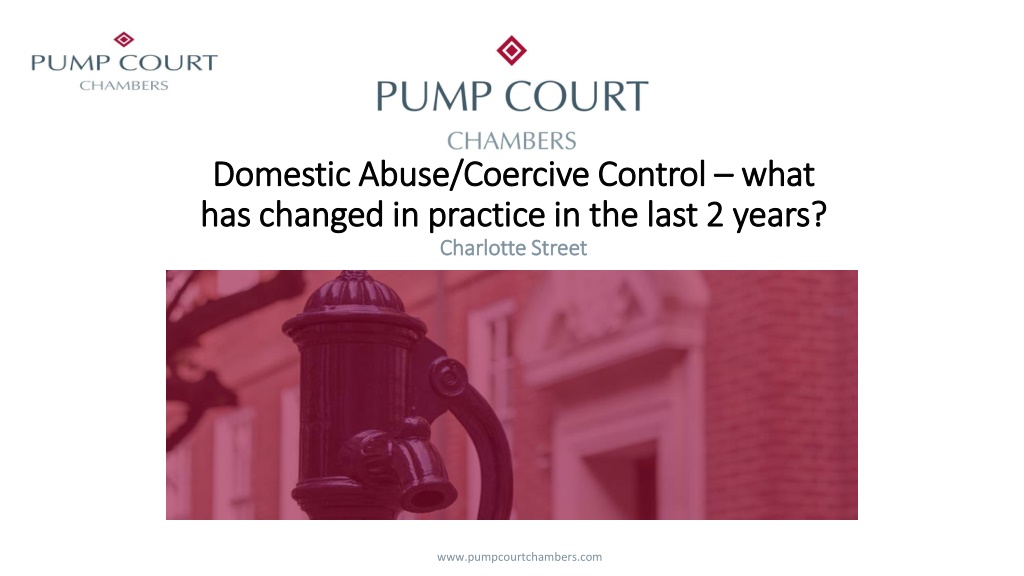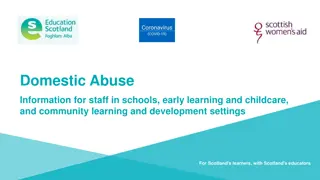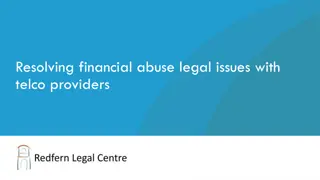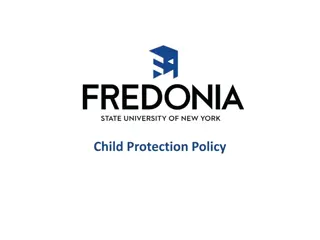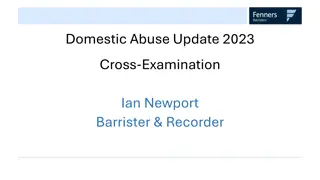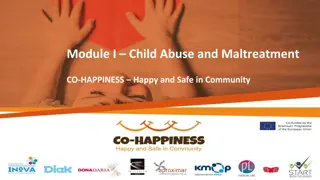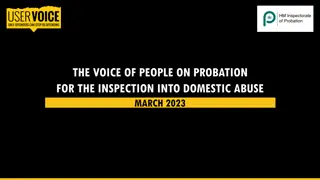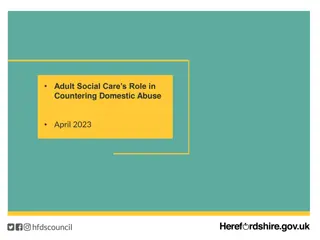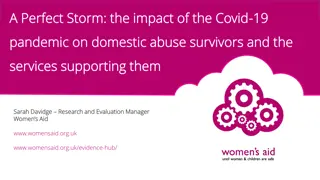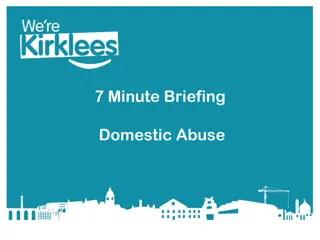Understanding Changes in Domestic Abuse Practices Over the Last 2 Years
In the realm of domestic abuse and coercive control, there have been notable developments in practice over the past two years. From defining behaviors that constitute domestic abuse to recognizing economic abuse and the impact of coercive and controlling behaviors, the legal landscape has evolved to provide better protection and support for victims. Recent cases have shed light on the various forms of abuse, such as gaslighting, and emphasized the importance of recognizing and addressing these harmful behaviors.
Download Presentation

Please find below an Image/Link to download the presentation.
The content on the website is provided AS IS for your information and personal use only. It may not be sold, licensed, or shared on other websites without obtaining consent from the author. Download presentation by click this link. If you encounter any issues during the download, it is possible that the publisher has removed the file from their server.
E N D
Presentation Transcript
Domestic Abuse/Coercive Control Domestic Abuse/Coercive Control what has changed in practice in the last 2 years? has changed in practice in the last 2 years? Charlotte Street Charlotte Street what www.pumpcourtchambers.com
Re H-N and Others (Domestic Abuse: Finding of Fact hearings) [2021 ] EWCA Civ 448. What evidence and how to marshal it Special measures Definition QLR Notable Cases
(2) Behaviour of a person (A) towards another person (B) is domestic abuse if (a) A and B are each aged 16 or over and are personally connected to each other, and (b) the behaviour is abusive. (3) Behaviour is abusive if it consists of any of the following (a) physical or sexual abuse; (b) violent or threatening behaviour; (c) controlling or coercive behaviour; (d) economic abuse (see subsection (4)); (e) psychological, emotional or other abuse; and it does not matter whether the behaviour consists of a single incident or a course of conduct. Definition PD 12J 2 (4) Economic abuse means any behaviour that has a substantial adverse effect on B s ability to (a) acquire, use or maintain money or other property, or (b) obtain goods or services. (5) For the purposes of this Act A s behaviour may be behaviour towards B despite the fact that it consists of conduct directed at another person (for example, B s child). 2B. For the avoidance of doubt, it should be noted that domestic abuse includes, but is not limited to, forced marriage, honour-based violence, dowry-related abuse and transnational marriage abandonment
PD12J 3 coercive behaviour means an act or a pattern of acts of assault, threats, humiliation and intimidation or other abuse that is used to harm, punish, or frighten the victim; controlling behaviour means an act or pattern of acts designed to make a person subordinate and/or dependent by isolating them from sources of support, exploiting their resources and capacities for personal gain, depriving them of the means needed for independence, resistance and escape and regulating their everyday behaviour; Considered by Hayden J in F v M [2021] EWFC (Fam) The types of behaviour set out in the definition are non-exhaustive; may appear in other guises At the core of coercion is the objective to harm, punish, or frighten the victim; Controlling behaviour is designed to corrode personal autonomy Coercive Control Gaslighting is an aspect of control Re B-B [2022] EWHC 108 (Fam) Cobb J the term 'gaslighting' conduct represented a form of insidious abuse designed to cause the mother to question her own mental well-being, indeed her sanity.
Shift of focus towards behaviour in the family. FFH: Relevance, purpose, proportionality Helpful practical guidance for judges and magistrates concerning fact finding hearings and domestic abuse in Private Law children proceedings: https://www.judiciary.uk/wp-content/uploads/2022/05/Fact-Finding-Hearings-and- Domestic-Abuse-in-Private-Law-Children-Proceedings.pdf Re H-N and Others (Domestic Abuse: Finding of Fact hearings) [2021 ] EWCA Civ 448. Para 31: A pattern of coercive and/or controlling behaviour can be as abusive as or more abusive than any particular factual incident that might be included in a schedule harm to a child in an abusive household is not limited to cases of actual violence to the child or to the parent. A pattern of abusive behaviour is as relevant to the child as to the adult victim. The child can be harmed in any one or a combination of ways for example where the abusive behaviour: Is directed against, or witnessed by, the child; Causes the victim of the abuse to be so frightened of provoking an outburst or reaction from the perpetrator that she/he is unable to give priority to the needs of her/his child; Creates an atmosphere of fear and anxiety in the home which is inimical to the welfare of the child; Risks inculcating, particularly in boys, a set of values which involve treating women as being inferior to men.
Para 32: not all directive, assertive, stubborn or selfish behaviour, will be 'abuse' in the context of proceedings concerning the welfare of a child; much will turn on the intention of the perpetrator of the alleged abuse and on the harmful impact of the behaviour. We would endorse the approach taken by Peter Jackson LJ in Re L (Relocation: Second Appeal) [2017] EWCA Civ 2121 (paragraph 61): "Few relationships lack instances of bad behaviour on the part of one or both parties at some time and it is a rare family case that does not contain complaints by one party against the other, and often complaints are made by both. Yet not all such behaviour will amount to 'domestic abuse', where 'coercive behaviour' is defined as behaviour that is 'used to harm, punish, or frighten the victim ' and 'controlling behaviour' as behaviour 'designed to make a person subordinate ' In cases where the alleged behaviour does not have this character it is likely to be unnecessary and disproportionate for detailed findings of fact to be made about the complaints; indeed, in such cases it will not be in the interests of the child or of justice for the court to allow itself to become another battleground for adult conflict." Re H-N and Others (Domestic Abuse: Finding of Fact hearings) [2021 ] EWCA Civ 448.
Para 58 Where one or both parents assert that a pattern of coercive and/or controlling behaviour existed, and where a fact-finding hearing is necessary in the context of PD12J, paragraph 16, that assertion should be the primary issue for determination at the fact- finding hearing. Any other, more specific, factual allegations should be selected for trial because of their potential probative relevance to the alleged pattern of behaviour, and not otherwise, unless any particular factual allegation is so serious that it justifies determination irrespective of any alleged pattern of coercive and/or controlling behaviour (a likely example being an allegation of rape). Re H-N and Others (Domestic Abuse: Finding of Fact hearings) [2021 ] EWCA Civ 448. The focus for the Family Court should be on how the parties behaved and what they did with regard to each other and their children, rather than whether the behaviour falls within a definition of a serious crime (eg. rape). Serious behaviour might not contain all ingredients of the offence but might still be profoundly abusive. Such behaviour should not be ignored. Because the overwhelming majority of domestic abuse (particularly abuse perpetrated by men against women) is underpinned by coercive control
Para 37: The court will carefully consider the totality of PD12J, but to summarise, the proper approach to deciding if a fact-finding hearing is necessary is, we suggest, as follows: The first stage is to consider the nature of the allegations and the extent to which it is likely to be relevant in deciding whether to make a child arrangements order and if so in what terms (PD12J.5). In deciding whether to have a finding of fact hearing the court should have in mind its purpose (PD12J.16) which is, in broad terms, to provide a basis of assessment of risk and therefore the impact of the alleged abuse on the child or children. Careful consideration must be given to PD12J.17 as to whether it is 'necessary' to have a finding of fact hearing, including whether there is other evidence which provides a sufficient factual basis to proceed and importantly, the relevance to the issue before the court if the allegations are proved. Under PD12J.17 (h) the court has to consider whether a separate fact-finding hearing is 'necessary and proportionate'. The court and the parties should have in mind as part of its analysis both the overriding objective and the President's Guidance as set out in 'The Road Ahead . Re H-N and Others (Domestic Abuse: Finding of Fact hearings) [2021 ] EWCA Civ 448. Per President's Guidance 'The Road Ahead' (June 2020), and reiterated by Cobb J in Re B-B: '43.If the Family Court is to have any chance of delivering on the needs of children or adults who need protection from abuse, or of their families for a timely determination of applications, there will need to be a very radical reduction in the amount of time that the court affords to each hearing. Parties appearing before the court should expect the issues to be limited only to those which it is necessary to determine to dispose of the case, and for oral evidence or oral submissions to be cut down only to that which it is necessary for the court to hear.'
Further pointers at paras 58 & 59 of Re H-N a) PD12J (as its title demonstrates) is focussed upon 'domestic violence and harm' in the context of 'child arrangements and contact orders'; it does not establish a free-standing jurisdiction to determine domestic abuse allegations which are not relevant to the determination of the child welfare issues that are before the court; Re H-N and Others (Domestic Abuse: Finding of Fact hearings) [2021 ] EWCA Civ 448. b) PD12J, paragraph 16 is plain that a fact-finding hearing on the issue of domestic abuse should be established when such a hearing is 'necessary' in order to: i) Provide a factual basis for any welfare report or other assessment; ii) Provide a basis for an accurate assessment of risk; iii) Consider any final welfare-based order(s) in relation to child arrangements; or iv) Consider the need for a domestic abuse-related activity. c) Where a fact-finding hearing is 'necessary', only those allegations which are 'necessary' to support the above processes should be listed for determination; d) In every case where domestic abuse is alleged, both parents should be asked to describe in short terms (either in a written statement or orally at a preliminary hearing) the overall experience of being in a relationship with each other.
What evidence? Cobb J in Re B-B (para 6(v)) The evidence of the principal parties is always likely to be far more valuable than the evidence of supporting witnesses; at the case management stage, judges should rigorously test with the parties and/or their advocates (and review for themselves) what (if any) real value is likely to be brought to the enquiry by the evidence of third parties; If police disclosure/medical disclosure may be relevant, obtain the necessary direction as soon as possible, ideally at the FHDRA. A pre-hearing review is likely to be helpful in a complex case to make sure the case is ready and can be combined with a ground rules hearing. What evidence and how to marshal it
How to marshal the evidence: Scott Schedule/ Statement? As discussed at paras 41-49 of Re H-N Whilst material needs to be organised and structured (the benefit of a scott schedule), patterns of behaviour require the court to focus on the wider context and cumulative impact. They are not identified from the consideration of individual, separate/ isolated incidents listed by reference to a particular date and time. The practice of limiting the number of allegations to be tried tends to distort the portrayal of the relationship and restricts the Court s vantage point/ ability to consider patterns of behaviour (particularly those more subtle and persistent). Isolated findings may appear less significant. What evidence and how to marshal it Peel J in GK v PR [2021] EWFC 106 noted that a scott schedule risks the judge approaching the case in a formulaic, incident by incident way which detracts from the holistic overview necessary to determine fluid and nuanced patterns. It also runs the risk that incidents which may appear trivial are overlooked and not relied upon .
How to marshal the evidence: Scott Schedule/ Statement? 48 Re H-N Quite how a move away from the use of Scott Schedules is to be achieved, and what form any replacement 'pleading' might take, does, however, raise difficult questions A number of suggestions were made including; a 'threshold' type document, similar to that used in public law proceedings, formal pleadings by way of particulars of claim as seen in civil proceedings and a narrative statement in prescribed form. The particular advantage of a narrative statement was, it was submitted, that it would allow there to be a focus on the overall nature of the relationship and expressly whether a party says that she had been harmed as a result of the behaviour and, if so, in what manner. Such an approach would allow the court to identify at an early stage whether an allegation of controlling and coercive behaviour is in issue. Identifying the form of harm (which may be psychological) and only then looking back at the more granular detail, would, it was submitted, allow the court to determine what specific facts need to be determined at a fact-finding hearing. What evidence and how to marshal it
Re B-B, does Cobb J posit the preferred solution at para 6? Consider the evidence relevant to each different form of alleged domestic abuse in 'clusters . Whilst the evidence will overlap in places, looking at it this way will build a picture of the nature of the relationship and make it easier to see whether patterns of behaviour emerge, which may not be so apparent from free-standing items on a Scott Schedule. It is the cumulative effect of individual incidents within each of those clusters of abuse-type, and of each type of abuse on the other, which give the clearest indication of the experience of abuse. Preference for a threshold style document setting out the alleged categories/facets of abuse (by reference to PD12J), with sufficient particularisation of incidents under each main heading? What evidence and how to marshal it Can be supported by a narrative statement. In Re JK (Domestic Abuse: Finding of Fact Hearing) [2021] EWHC 1367 (Fam) para 27 Poole J considered concise statements of each party would be helpful, including (a) a summary of the nature of the relationship, (b) a list of the forms of domestic abuse that the evidence is said to establish, (c) a list of key specific incidents said to be probative of a pattern of coercion and/or control; (d) a list of any other specific incidents so serious that they justify determination irrespective of any alleged pattern of coercive and/or controlling behaviour. which specific allegations listed at (d) were admitted or disputed, but, no need to have formal responses to the other sections of the statements.
The court must identify any party or witness who is a vulnerable person at the earliest possible stage of the proceedings (PD3AA 1.3). Where a person 'is, or is at risk of being, a victim of domestic abuse', the court must assume that their participation and evidence will be reduced by reason of vulnerability: ie. they are assumed to be a vulnerable person These are obligations imposed upon the court, by use of the words "must" and "duty of the court". When considering the vulnerability of a party or witness as mentioned in rule 3A.4 or 3A.5, the court must have regard in particular to the matters set out in paragraphs (a) to (j) and (m) of rule 3A.7. Special measures The court must consider whether a party's participation in the proceedings (other than by way of giving evidence) (r.3A.4(1)); or the quality of evidence given by a party or witness (r.3A.5 (1)) is likely to be diminished by reason of vulnerability and, if so, whether it is necessary to make one or more participation directions to assist (a) the protected party participating in proceedings; or (b) the protected party giving evidence (r. 3A.6 (1)). Before doing so, the court must consider any views expressed by the party or witness about giving evidence.
The particular considerations to which the court must have regard when deciding whether to make one or more participation directions are set out at R.3A.7. They include: (a) the impact of any actual or perceived intimidation, including any behaviour towards the party or witness on the part of (i) any other party or other witness to the proceedings or members of the family or associates of that other party or other witness; or (ii) any members of the family of the party or witness; (d) the issues arising in the proceedings including (but not limited to) any concerns arising in relation to abuse; (NB. PD3AA 2.1: when considering the question of vulnerability, this reference to abuse includes inter alia, domestic, sexual, physical and emotional abuse.) And matters such as (b) mental disorder/significant impairment of intelligence or social functioning (g) the social and cultural background & ethnic origins; (h) the domestic circumstances and religious beliefs of the party or witness; (j) any characteristic of the party or witness relevant to the participation direction which may be made; (k) whether any measure is available to the court; (l) the costs of any available measure; and (m) any other matter set out in Practice Direction 3AA. Special measures
Special measures are (r.3A.8) (1) measures which: (a) prevent a party or witness from seeing another party or witness; (b) allow a party or witness to participate in hearings and give evidence by live link; (c) provide for a party or witness to use a device to help communicate; (d) provide for a party or witness to participate in proceedings with the assistance of an intermediary; (e) provide for a party or witness to be questioned in court with the assistance of an intermediary; or (f) do anything else which is set out in Practice Direction 3AA. Special measures (2) If the family court makes a direction for a measure which is not available where the court is sitting, it may direct that the court will sit at the nearest or most convenient location where the family court sits and the measure is available
Where the court is satisfied a vulnerable party or witness should give evidence, PD3AA mandates a ground rules hearing (or ground rules component of a hearing) before that person gives evidence (PD3AA, para. 5.2). Within ground rules, the court should consider inter alia: The conduct of advocates / parties and any support for the person giving evidence (PD3AA, para. 5.2); The form of the evidence, "for example whether it should be oral or other physical evidence, such as through sign language or another form of direct physical communication" (PD3AA, para. 5.3); The way in which the evidence is taken, including "whether the person's oral evidence should be given at a point before the hearing, recorded and, if the court so directs, transcribed, or given at the hearing with, if appropriate, participation directions being made" (PD3AA, para. 5.4); Directing the manner of any cross-examination: eg. whether to direct that questions or topics should be agreed prior to the hearing; whether questions should be put by one legal representative or advocate alone (PD3AA, para. 5.); Whether a vulnerable party, vulnerable witness or protected party has previously given evidence/ been cross-examined and whether that evidence and cross-examination has been pre-recorded/ given a recorded interview not used in previous criminal or family proceedings. If so, and if any such recordings are available, the court should consider their being used in the family proceedings (PD3AA, para. 5.6). Special measures
PD 3AA 6.1 sets out the matters to be included in an application form for directions under r.3A.10(2) FPR a) why the party or witness would benefit from assistance; aa) whether the party or witness falls within the assumption at rule 3A.2A FPR 177057 b) the measure or measures that would be likely to maximise as far as practicable the quality of that evidence; c) why the measure or measures sought would be likely to improve the person s ability to participate in the proceedings; and d) why the measure or measures sought would be likely to improve the quality of the person s evidence. Special measures
Section 65 of the DAA 2021 prohibits perpetrators/ alleged perpetrators of abuse from personally cross-examining their victims/ alleged victims. The prohibition (where automatic) also applies in reverse, to prevent a victim from having to cross-examine his or her abuser or alleged abuser. The automatic prohibition applies in the following situations: Where a party has been cautioned for, charged with or convicted of a specified offence against the victim or alleged victim, they cannot cross-examine in person the victim or alleged victim of that offence and vice versa. No party to the proceedings against whom an on-notice protective injunction is in force may cross-examine in person a witness who is protected by the injunction and vice versa. Where specified evidence is adduced that a person who is a witness has been the victim of domestic abuse carried out by a party to the proceedings, that party to the proceedings may not cross-examine the witness in person and vice versa. The lists of specified offences, on-notice protective injunctions and specified evidence are set out in the Prohibition of Cross-Examination in Person (Civil and Family Proceedings) Regulations 2022. QLR
Where none of the automatic prohibitions apply, the court has the power to direct that a party be prohibited from carrying out in person cross-examination where it appears to the court that allowing cross-examination in person would be likely to affect the quality of the witness evidence or is likely to cause either the party or the witness significant distress and it would not be contrary to the interests of justice to give such a direction. The quality condition is met if the quality of evidence given by the witness on cross- examination: is likely to be diminished if the cross-examination (or continued cross-examination) is conducted by the party in person, and would be likely to be improved if a direction were given by the court. The significant distress condition is met if: the cross-examination (or continued cross-examination) of the witness by the party in person would be likely to cause significant distress to the witness or the party, and that distress is likely to be more significant than would be the case if the witness were cross-examined other than by the party in person. QLR
This is a wide discretion and might apply, eg, where domestic abuse is alleged but the allegations do not trigger any of the automatic prohibitions, where LIP have to cross-examine expert witnesses, or for reasons other than domestic abuse. The court must state its reasons for giving a direction, refusing an application, revoking a direction, etc. The court must consider whether there is a satisfactory alternative means for the witness to be cross-examined, or for obtaining that evidence. The judge cross examining is not a satisfactory alternative. If the court concludes that there is no satisfactory alternative, the court must invite the prohibited party to arrange for a qualified legal representative (QLR) to conduct the cross-examination and require the party to notify the court within a specified time whether a QLR is to conduct the cross-examination. QLR If the party does not appoint such a representative/notifies the court that no such representative is to act, the court must consider whether it is necessary in the interests of justice for the court to appoint a QLR. If so, the court must appoint and choose a QLR. If court appointed, the QLR is publicly funded and paid from central funds. Standard Orders for cross examination and QLR provisions are available at: https://www.judiciary.uk/guidance-and-resources/message-from-mr-justice-peel-standard- orders-cross-examination-and-qlr-provisions/
PD12J 4A 4A.1 Section 91(14) leaves a discretion to the court to determine the [many and varied] circumstances in which an order should be made s. 91A specifies certain circumstances among others in which the court may make an order. These circumstances include where an application would put the child concerned, or another individual at risk of harm. This would include, but not be limited to, a risk of harm arising where an application could be used to carry out or continue domestic abuse. A future application could be part of a pattern of coercive or controlling behaviour or other domestic abuse toward the victim, such that a section 91(14) order is merited due to the risk of harm to the child or other individual. 4A.2 Where allegations of domestic abuse are alleged or proven, the court should consider whether a section 91(14) order might be appropriate even if an application for such an order has not been made. (Section 91A(5) of the 1989 Act specifies who can make an application, and provides that the court can make an order of its own motion.) 4A.3 The court should refer to Practice Direction 12Q for guidance on section 91(14) applications and orders. Consider s.91(14) Orders Consider the update to Re P guidance in Re A (A CHILD) (supervised contact) (s91(14) Children Act 1989 orders) [2021] EWCA Civ 1749 judgment before the DAA 2021 came into force, but reference made to it.
K v K [2022] EWCA Civ 468 General guidance from the CA on the proper approach to FFH following the decision in Re H-N. Re H-N did not impose a requirement for a finding of fact hearing in every case in which domestic abuse is alleged [67]. FFH is only needed if the alleged abuse is likely to be relevant to what the court is being asked to decide relating to the children s welfare [45]. Notable Cases Any MIAM exemption must be validly claimed; the court at FHDRA should inquire into this, pursuant to r. 3.10(1) FPR. If an exception has not been validly claimed, the court may direct the parties to attend a MIAM and adjourn the proceedings to enable the parties to do so, pursuant to r.3.10(2) [31]. Consider in particular paras 65 67 (overleaf)
65. A fact-finding hearing is not free-standing litigation. It always takes place within proceedings to protect a child from abuse or regarding the child s future welfare. It is not to be allowed to become an opportunity for the parties to air their grievances. Nor is it a chance for parents to seek the court s validation of their perception of what went wrong in their relationship. If fact-finding is to be justified in the first place or continued thereafter, the court must be able to identify how any alleged abusive behaviour is, or may be, relevant to the determination of the issues between the parties as to the future arrangements for the children. 66. At the risk of repeating what has been said at [37] in Re H-N and at [41] above, the main things that the court should consider in deciding whether to order a fact-finding hearing are: (a) the nature of the allegations and the extent to which those allegations are likely to be relevant to the making of the child arrangements order, (b) that the purpose of fact-finding is to allow assessment of the risk to the child and the impact of any abuse on the child, (c) whether fact-finding is necessary or whether other evidence suffices, and (d) whether fact-finding is proportionate. Notable Cases 67. It seems that a misunderstanding of the court s role has developed. There is a perception that the Court of Appeal has somehow made it a requirement that in every case, in which allegations of domestic abuse are made, it is incumbent upon the court to undertake fact-finding, involving a detailed analysis of each specific allegation made. That is not the case. As Re H-N explained and we reiterate here, the duty on the court is limited to determining only those factual matters which are likely to be relevant to deciding whether to make a child arrangements order and, if so, in what terms.
B v P [2022] EWFC B18 HHJ Levey allowed an appeal against the decision of a DJ following a finding of fact hearing, in which she found most of the mother s allegations not proved. The DJ fell into error inter alia because: She did not follow the approach suggested in Re H-N and instead approached the allegations individually, without standing back to consider the overall picture/ the nature of the behaviour as a whole [51]. The DJ made findings of abuse but did not then go on to consider whether that was a pattern of behaviour [52]. The DJ found that the perpetrator had said unpleasant things but did not make a finding of verbal abuse and thus DA under PD12J. A number of incidents were admitted by the respondent, which the judge should have considered in the context of the respondent's behaviour as a whole, as she was required to do following the decision in Re H-N. She failed to do so. Notable Cases A ground rules hearing had not been held and the DJ made no reference to Part 3A, PD3AA or PD12J in her judgment. The court must consider PD12J and special measures in every case where domestic abuse is alleged. The obligation to consider special measures lies with the court, but there is an expectation on legal representatives do so [44].
CM v IP [2022] EWHC 2755 (Fam) Morgan J highlighted the obligation to give consideration to PD12J at the earliest opportunity and to keep the matter under review throughout the court process [39]. A CJ refused Mother s application for the matter to be retracked to comply with PD12J, ie. For fact-finding hearing, and failed to make participation directions. The CJ s judgment did not refer to DAA 2021 s. 63 or FPR Part 3A or PD3AA. There was no ground rules hearing held in advance or in the morning of the substantive hearing. The Mother s appeal was successful. Notable Cases Whilst the Court recorded that it considered a fact-finding hearing not necessary or proportionate [notwithstanding the allegations of domestic abuse] because of the extent of the relevance of those allegations to the matters the court is determining today and because of the content of the welfare reports of the Children's Guardian [who considered the allegations to be mainly historic and do not prevent safe arrangements for the child being made whilst keeping contact between the parents to the minimum]. Morgan J was concerned that the CJ appeared not to have considered matters contained in PD12J para 17 [42], ie. whether the nature and extent of the allegations, if proved, would be relevant to the issues before the court , nor to have explained any conclusions reached.
The CJ did not provide an analysis as to how the views of the guardian fed into his own decision making [44]. Nor did the judge focus appropriately on the allegations of coercive and controlling behaviour and consider them alongside the guidance from Re H-N (quoting Re H-N at para 50, the overwhelming majority of domestic abuse (particularly abuse perpetrated by men against women) is underpinned by coercive control and it is the overarching issue that ought to be tried first by the court')[45]. Notable Cases
Re A (A Child: Findings of Fact) [2022] EWCA Civ 1652 Appeal against the decision of a Deputy High Court Judge following a FFH. The mother s allegations were grouped together under seven heads: stranding, physical abuse and threats, sexual abuse, controlling and coercive behaviour, emotional and psychological abuse, financial abuse, and abuse of the child. She made 41 allegations, referenced to her WS. The parties agreed the judge had a wide discretion as to approach; she was not expected to examine each of the 41 allegations in detail, but could, eg. examine a representative number of key allegations and then look at the picture as a whole when drawing her conclusions. Nor did she need to follow the order of pleadings, she could equally take the allegations in a different order, perhaps chronological. Notable Cases The key is sufficient analysis of the evidence overall and correlate the main elements with each other before reaching a final conclusion. The mother successfully appealed against the trial judge finding only the stranding allegations to be proved.
The CA found the judges assessment of the evidence to be lacking. She placed unjustifiable weight on the absence of corroboration at the expense of a broader assessment that took proper account of the predicaments of victims of an abusive relationship and of the inherent probabilities (the judge should have taken account of the findings she made (regarding stranding) and factored those into to assessment of credibility etc) [43]. Perpetration of domestic abuse is an expression of an aspect of a person's character within a relationship and the fact that a person is capable of being seriously abusive in one way inevitably increases the likelihood of them having been abusive in other ways. There is no indication that the judge acknowledged this. Instead, and despite her correct self-direction, she treated the various limbs of the mother's allegations as if they existed in unconnected compartments [42] Notable Cases The judge considered supportive of the father s case letters sent by the mother to the father in which she expressed her love for him, begged him to give her another chance, forgive her and return to their bedroom. The CA stated [26]: 26. I endorse the observations of Judd J in Re M [2021] EWHC 3225 (Fam): 82. The reason it was so important for the judge to give very careful consideration to the question of vulnerability in this case is because a vulnerable person may not act in the same way as someone more independent or confident if they are exploited or abused in a relationship. Such an individual may be so anxious for the relationship to succeed that they accept treatment that others would not. They may be easy to exploit. They may not even realise what is happening to them, and will cling to the dream of a happy family and relationship
Whilst the judge was aware of FPR 3A.2A and the assumption that the quality of the evidence of a victim of abuse would be diminished, she did not make that assumption or explain why she was not making it in her assessment of the mother s evidence [43]. The judge s assessments of the parties were not sustainable; she did not supply the reasoning necessary to justify her surprising conclusions [45]. The judge s refusal the morning of the FFH to adjourn the FFH to allow for an intermediary assessment of the mother was not open to any criticism [32]. The mother s representative applied in the alternative for a number of special measures, most of which were granted. The trial judge had referred to the court s duty to consider making participation directions and had rightly noted that this did not mean that an intermediary assessment was automatically required [31]. Notable Cases
